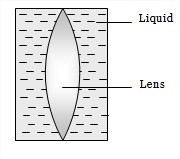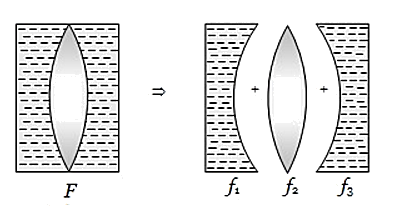12th Grade > Physics
OPTICS MCQs
Wave Optics, Ray Optics Refraction, Ray Optics Fundamentals, Ray Optics Curved Surface Refraction, Ray Optics Curved Mirrors
Total Questions : 111
| Page 2 of 12 pages
Answer: Option B. -> 2cos−1(μ2)
:
B
By using μ=sinisinr⇒μ=sin2rsinr=2sinrcosrsinr
⇒r=cos−1(μ2).So,i=2r=2cos−1(μ2)
:
B
By using μ=sinisinr⇒μ=sin2rsinr=2sinrcosrsinr
⇒r=cos−1(μ2).So,i=2r=2cos−1(μ2)
Question 12. Two plane mirrors P and Q are aligned parallel to each other, as shown in the figure. A light ray is incident at an angle of θ at a point just inside one end of A. The plane of incidence coincides with the plane of the figure. The maximum number of times the ray undergoes reflections (including the first one) before it emerges out is


Answer: Option B. -> 11
:
B
By using δ=(360−2θ)⇒300=360−2θ
⇒θ=30∘.Hence number of images =36030−1=11
:
B
By using δ=(360−2θ)⇒300=360−2θ
⇒θ=30∘.Hence number of images =36030−1=11
Answer: Option B. -> 158
:
B
−f1fa=(μ5−1)(μsμl−1)−2.5=0.5(1.5μl−1)−0.50.2=1.5−1(1.5μ1−1)1.5μl−1=−151.5μl=1−15=45μl=74=7540=158
:
B
−f1fa=(μ5−1)(μsμl−1)−2.5=0.5(1.5μl−1)−0.50.2=1.5−1(1.5μ1−1)1.5μl−1=−151.5μl=1−15=45μl=74=7540=158
Answer: Option C. -> 3R2
:
C
Consider the refraction of the first surface i.e. refraction from rarer medium to denser medium
μ2−μ1R=μ1−u+μ2v1⇒(32)−(43)R=43∞+32v1⇒v1=9R
Now consider the refraction at the second surface of the lens i.e. refraction from denser medium to rarer medium
1−32−R=−329R+1v2⇒v2=(32)R
The image will be formed at a distance of 32R.This is equal to the focal length of the lens.

:
C
Consider the refraction of the first surface i.e. refraction from rarer medium to denser medium
μ2−μ1R=μ1−u+μ2v1⇒(32)−(43)R=43∞+32v1⇒v1=9R
Now consider the refraction at the second surface of the lens i.e. refraction from denser medium to rarer medium
1−32−R=−329R+1v2⇒v2=(32)R
The image will be formed at a distance of 32R.This is equal to the focal length of the lens.

Answer: Option B. -> √3
:
B
Deviation by a aphere is 2(i -r) Here, deviation δ=60∘=2(i−r)
(or) i−r=30∘
∴ r=i−30∘=60∘−30∘=30∘
∴ μ=sinisinr=sin60∘sin30∘=√3
:
B
Deviation by a aphere is 2(i -r) Here, deviation δ=60∘=2(i−r)
(or) i−r=30∘
∴ r=i−30∘=60∘−30∘=30∘
∴ μ=sinisinr=sin60∘sin30∘=√3
Answer: Option B. -> √x1x2
:
B
Given u=(f+x1) and v=(f+x2)
The focal length f=uvu+v=(f+x1)(f+x2)(f+x1)+(f+x2)
On solving, we get f2=x1x2 or f=√x1x2
:
B
Given u=(f+x1) and v=(f+x2)
The focal length f=uvu+v=(f+x1)(f+x2)(f+x1)+(f+x2)
On solving, we get f2=x1x2 or f=√x1x2




















